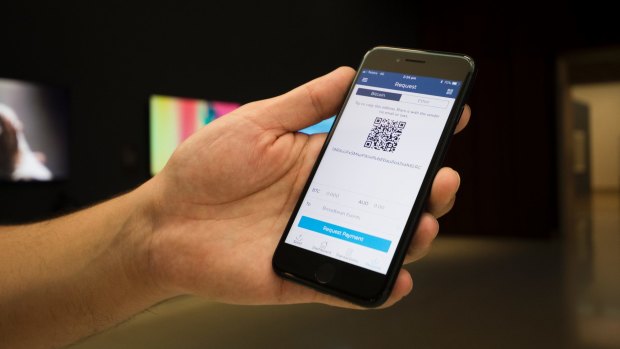This was published 4 years ago
Victoria building QR code check-in tool to bolster COVID defence
By Paul Sakkal
The Victorian government is developing a QR code check-in system based on technology used in NSW and the ACT that some epidemiologists believe is necessary to achieve gold-standard coronavirus contact tracing.
A government spokeswoman said the tool would allow users to scan a barcode at venues to register their attendance, and would bear hallmarks of an ACT system praised as a pillar of the territory's COVID-19 defence.
"As we start to reopen and move towards a COVID-normal, this technology will play a role in maintaining safe public environments and the response in containing future outbreaks," the spokeswoman said.
ACT Health has offered to give its system to the Victorian government for free. It is not yet clear if the Victorian system will be an app or a website, with detail expected to be announced in coming weeks.

QR codes can be scanned on devices like smartphones and smart watches.Credit: Dion Georgopoulos
The performance of Victoria's contact-tracing systems during its second wave of COVID-19 attracted criticism from the federal government, with Prime Minister Scott Morrison describing NSW as the "gold standard" and federal Health Minister Greg Hunt blaming shortcomings in Victoria for the extent of its crippling second wave. The system has since been overhauled with the establishment of localised contact-tracing hubs.
The ACT's QR (quick response) app, which has been in use since early September, allows users to scan into venues like restaurants and shops.
The technology, a similar version of which is used by NSW and countries including New Zealand and South Korea, allows contact tracers immediate access to information about who was in a venue at a specific time, speeding up the tracing process by eliminating the need to engage with businesses who may be using pen-and-paper systems.

ACT Health's CIO Peter O'HalloranCredit: ACT Health
NSW strongly encourages businesses to ask customers to use a government app. NSW and the ACT store the data for 28 days in both and mandate that it is not to be used for purposes other than contact tracing.
Burnet Institute epidemiologist Professor Mike Toole said Victoria should adopt centralised QR technology to minimise the time spent by contact tracers collating information. He said Victoria, as it reopened after a months-long lockdown, needed systems that support the quickest and most precise contact tracing.
"It's an excellent idea ... and it's worked well in South Korea since May," he said.
"It's going to be really important from now on heading into summer because we want to have the tightest possible contact tracing."
ACT Health's chief information officer, Peter O'Halloran, said the app was one of the territory's key defences against a potential reintroduction of COVID-19. He said other states had shown strong interest in using the software which would be provided to other jurisdictions for free.
"This is one of our key steps to keep open if there's another wave of cases. This will ensure we're ready," Mr O'Halloran said, adding the app had been downloaded more than 25,000 times and more than 2000 check-ins were recorded each day. More than 2.5 million QR check-ins were recorded on a single day in New Zealand in September.
Mr O'Halloran said ACT authorities settled on the QR scheme to ensure its contact tracing was as speedy as possible. When the territory was grappling with cases earlier this year (it has been almost virus-free since July) authorities struggled to obtain timely information from businesses using paper-based attendance logs that were sometimes lost or soiled with drinks, he said.
Premier Daniel Andrews said on Monday a paper-based system would be best for some businesses. "Often old-fashioned ways are the best way and there will be many small businesses who will write down and take great pride," he said.

Jeff Feldman, director and chief technology officer of Arden Street Labs.
Professor Toole said the system should be used by businesses that host more than about 10 people at any one time because, he said, these businesses would likely be less diligent in writing down names manually given the high volume of customers.
He said using QR codes would assist the government in its attempt to increase the amount of "upstream" or "backwards" contact tracing where authorities find contacts exposed to an infected person even before they became infectious. The labour- and time-intensive strategy seeks to locate the "index" case – the original spreader in a cluster.
Jeff Feldman, a developer involved in the creation of the ACT app, said the software underpinning QR code apps was simple and cheap. He said the app could be rolled out in Victoria in less than a week.
Mr Feldman – whose Victorian-based company Arden Street Labs provides digital COVID-19 screening systems to hospitals – said data was stored on servers that were rapidly accessible by contact tracers. These contact tracers would otherwise need to deal with any number of different attendance log systems used by businesses involved in a cluster, some of which may use their own digital systems, he said.
"You know where the data is, you know it's secure and private, and you know it's accessible," he said.
"One of the key things we need to do as we open up is leverage everything we have at our disposal.
"Lockdowns are useful as a short-term stopgap but during that time we need to build and prepare and develop novel solutions to help prepare."
Note from the Editor
The Age's editor, Gay Alcorn, writes an exclusive newsletter for subscribers on the week's most important stories and issues. Sign up here to receive it every Friday.